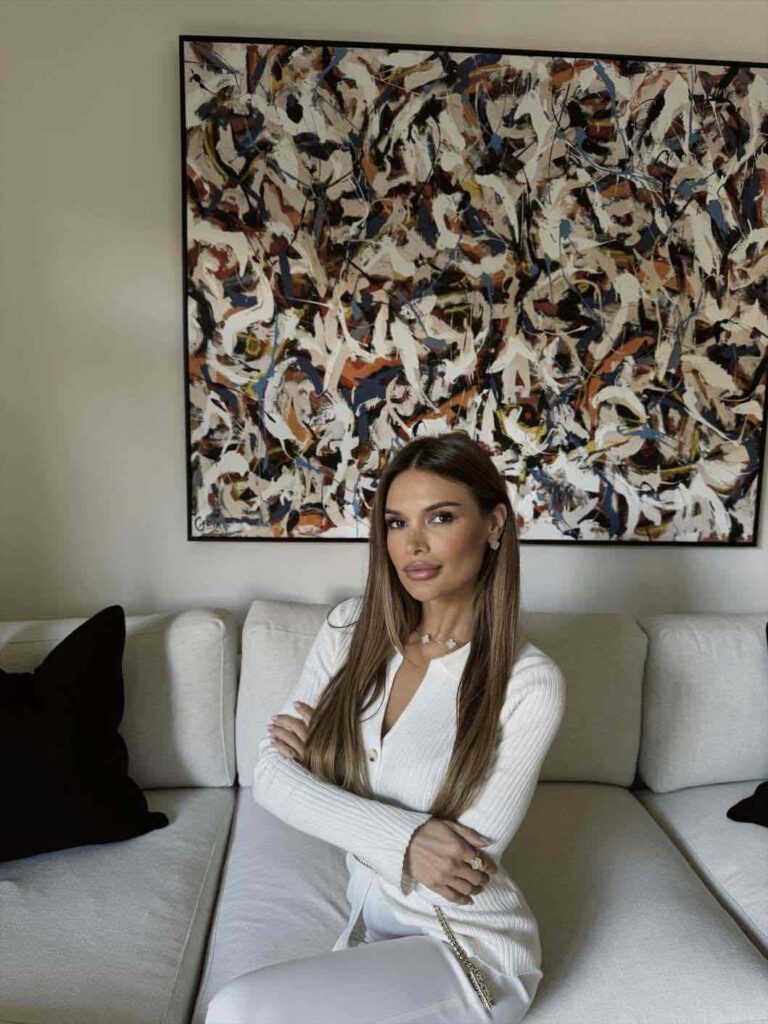By: Shawn Mars
The intersection of real estate, fashion, and art may not be immediately apparent to the casual observer, but for Sasha Harrison, these industries are deeply connected by vision, economy, and evolving trends. Her journey from fashion styling to real estate and, ultimately, the art world is a testament to her keen eye for aesthetics and her ability to recognize value—both emotional and financial. With a background in global commercial real estate and formal education in art history and art finance from Sotheby’s Institute of Art, Harrison has developed a holistic perspective on how these fields intersect and influence one another.
A Natural Progression: From Real Estate to Art
Harrison’s transition into the art world was not a departure from her previous experience but rather an evolution of her expertise. Her time in the real estate sector exposed her to the concept of appreciating assets—properties that gain value over time based on economic trends, location, and market demand. The same principles apply to fine art. With a trained eye for both aesthetics and financial growth, she recognized that art, like real estate and stocks, can be an asset class that appreciates over time. Her understanding of market dynamics allows her to see art not only as a form of personal and cultural expression but also as a strategic investment.
“For me, taste is everything,” Harrison explains. “It’s what connects fashion, art, and real estate. Whether choosing artwork or selecting profitable real estate, it all comes down to understanding what resonates with people on a deeper level.”
Art, like real estate, is deeply influenced by global economic trends. When economies flourish, both real estate markets and the art world experience growth, as investors and collectors seek tangible assets to diversify their portfolios. This connection has fueled Harrison’s passion for educating others about the value of art in a broader financial and cultural context.
A Global Perspective on Art
Harrison’s international background has played a crucial role in shaping her approach to art. Having lived in Moscow, Barcelona, and Los Angeles, she has been exposed to diverse artistic landscapes that have enriched her understanding of global art movements. Moscow deepened her appreciation for Neoclassicism and Avant-Garde, Barcelona introduced her to Cubism and Surrealism, and Los Angeles exposed her to the dynamic intersection of contemporary art and pop culture.
“Art is a universal language,” she says. “It tells stories of culture, history, and philosophy that transcend boundaries. Living in multiple countries allowed me to experience how different societies use art to communicate their identity and heritage.”
Harrison also emphasizes that global events shape artistic expression. Whether it is economic shifts, social movements, or environmental crises, art often becomes a reflection of the times. Similarly, economic downturns and political changes often spark new artistic movements that challenge norms and provoke thought.
A Vision for the Future
Looking ahead, Harrison aims to expand her influence within the realms of real estate and art. She envisions creating a platform that seamlessly merges art, investment, and cultural appreciation—empowering others to navigate these industries with confidence. Rather than focusing solely on the financial aspects of art, she seeks to foster a deeper understanding of its role in shaping society and reflecting economic trends.
“There’s a fine line that connects fashion, art, and real estate,” Harrison explains. “When you understand how these industries influence one another, you can navigate them with greater confidence and insight.”
Her goal is not just to engage with the art market but to help bridge gaps between disciplines, demonstrating how artistic vision and economic trends are intertwined. By leveraging her background in real estate and fashion, she provides a unique perspective that highlights the multifaceted value of art—both as a cultural touchstone and a strategic asset.
As she continues her journey, Sasha Harrison stands as a testament to the power of cross-industry expertise. Her work underscores the idea that art is more than an aesthetic pursuit—it is a dynamic force shaped by global economies, personal vision, and cultural evolution.
We asked Sasha Harrison a few questions about the similarities between the art and real estate industries.

Q: What inspired you to pursue formal education in art?
Sasha: I’ve always been surrounded by art in different forms since childhood. But I wanted to deepen my understanding on a more intellectual level. That’s when I decided to study at Sotheby’s Institute of Art, focusing on art history and art finance. It gave me the tools to connect the emotional side of art with its financial and investment potential. Living in multiple countries also exposed me to countless museums, galleries, and art events, which further fueled my passion.
Q: How do you see the connection between fashion, art, and real estate?
Sasha: They are all deeply influenced by vision and trends in the economy. Fashion taught me about aesthetics and personal expression, art adds depth and history to that expression, and real estate provides a tangible, long-term way to reflect economic perspectives. When the economy grows, the global real estate market expands, and so does the art market. Understanding this connection allows one to navigate these industries with greater insight.
Q: You’ve lived in Moscow, Barcelona, and Los Angeles. How have those experiences shaped your approach to art?
Sasha: Living in different countries exposed me to unique artistic landscapes and helped me see how art transcends cultural boundaries. Each place has its own way of expressing history and philosophy through art. Moscow gave me a strong appreciation for traditional fine art, Barcelona introduced me to modernism, and Los Angeles taught me about the intersection of art with pop culture and global events. Experiencing these different perspectives has enriched my understanding of the global art market.
Q: Speaking of global events, you mentioned that world crises can inspire artists. Can you elaborate?
Sasha: Absolutely. Art is deeply connected to the world around us. Economic shifts, social movements, and environmental crises all influence artistic expression. For example, the wildfires in Los Angeles or major economic changes affect not just people but the art they create. These events inspire artists to turn tragedy into powerful expressions of protest, hope, and resilience. Art becomes a tool for reflection, change, and inspiration.
Q: What challenges have you faced in building your career?
Sasha: Moving between countries has always been a challenge, especially when trying to establish myself in different markets. But it has also been a blessing because it allowed me to understand how art, culture, and economy vary globally. One of my biggest goals has been to help artists bring their work to new audiences and show how art can connect people across borders. My journey has been about constantly learning and adapting, which has only strengthened my passion for bridging these worlds.
Sasha Harrison continues to expand her influence in real estate and art, bringing a unique perspective that blends investment acumen with artistic appreciation. Her work underscores the idea that art is more than an aesthetic pursuit—it is a dynamic force shaped by global economies, personal vision, and cultural evolution.
Instagram @ms_sashsash.
Published by Anne C.

















